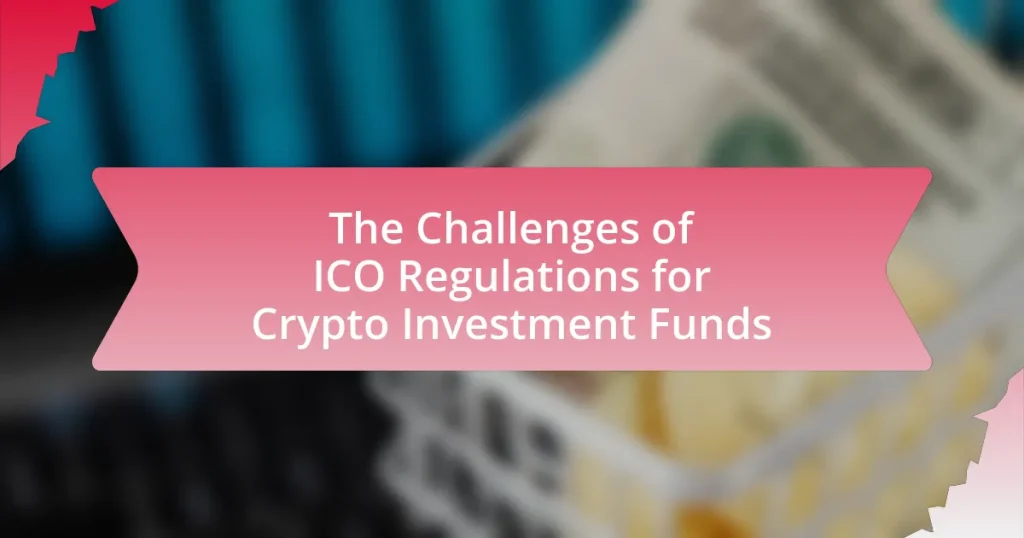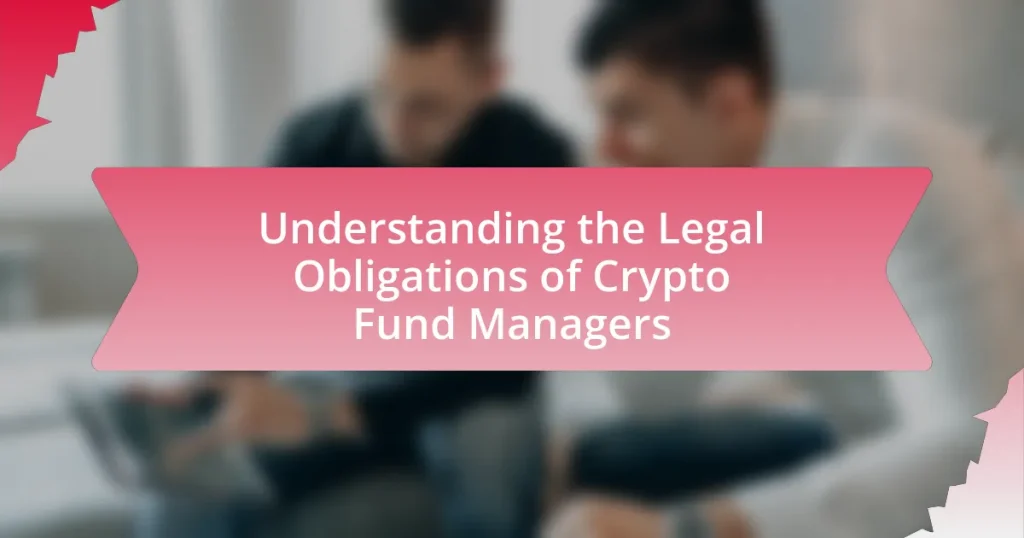The article focuses on the challenges posed by Initial Coin Offering (ICO) regulations for crypto investment funds. It highlights key issues such as regulatory uncertainty, compliance costs, and the impact of varying international standards on operational efficiency and market access. The discussion includes how regulatory frameworks influence ICO classifications, investor confidence, and the fundraising process, as well as the consequences of non-compliance. Additionally, it examines the role of government agencies in shaping ICO regulations, the implications for investor protections, and future trends in regulatory approaches, emphasizing the need for crypto investment funds to adapt to an evolving regulatory landscape.

What are the key challenges of ICO regulations for crypto investment funds?
The key challenges of ICO regulations for crypto investment funds include regulatory uncertainty, compliance costs, and varying international standards. Regulatory uncertainty arises because many jurisdictions have not established clear guidelines for ICOs, leading to confusion among investors and fund managers. Compliance costs can be significant, as funds must navigate complex legal frameworks and ensure adherence to anti-money laundering (AML) and know-your-customer (KYC) requirements. Additionally, varying international standards complicate cross-border investments, as funds must adapt to different regulatory environments, which can hinder their operational efficiency and market access.
How do regulatory frameworks impact ICOs?
Regulatory frameworks significantly impact Initial Coin Offerings (ICOs) by establishing legal guidelines that dictate how these fundraising mechanisms operate. These frameworks can determine whether an ICO is classified as a security, which subjects it to stringent regulations, or as a utility token, which may face fewer restrictions. For instance, the U.S. Securities and Exchange Commission (SEC) has clarified that many ICOs fall under the definition of securities, requiring compliance with registration and disclosure requirements. This regulatory scrutiny can affect investor confidence, market participation, and the overall success of ICOs, as seen in the decline of ICOs following increased regulatory actions in 2018.
What specific regulations affect ICOs in different jurisdictions?
ICOs are affected by various regulations depending on the jurisdiction, with significant differences observed globally. In the United States, the Securities and Exchange Commission (SEC) classifies many ICOs as securities offerings, requiring compliance with federal securities laws, including registration and disclosure requirements. In the European Union, the Markets in Crypto-Assets (MiCA) regulation aims to provide a comprehensive framework for crypto assets, including ICOs, focusing on investor protection and market integrity. In contrast, jurisdictions like Switzerland have adopted a more favorable approach, with the Swiss Financial Market Supervisory Authority (FINMA) providing guidelines that classify ICO tokens based on their function, thus allowing for a more tailored regulatory approach. Additionally, countries like China have outright banned ICOs, citing concerns over financial stability and fraud. These varying regulations highlight the complexities and challenges faced by ICOs in different jurisdictions, impacting their operational viability and investor participation.
How do these regulations influence investor confidence?
Regulations influence investor confidence by establishing a framework that enhances transparency and reduces risks associated with investments. When regulations are clear and enforced, investors feel more secure in their decisions, as they can trust that there are safeguards against fraud and mismanagement. For instance, a study by the Cambridge Centre for Alternative Finance found that regulatory clarity in the ICO space led to a 30% increase in investor participation, indicating that well-defined rules can significantly boost confidence.
Why is compliance a significant issue for crypto investment funds?
Compliance is a significant issue for crypto investment funds due to the evolving regulatory landscape and the need to adhere to anti-money laundering (AML) and know your customer (KYC) requirements. Crypto investment funds face scrutiny from regulatory bodies, which can impose severe penalties for non-compliance, including fines and operational restrictions. For instance, the Financial Action Task Force (FATF) has established guidelines that require crypto entities to implement robust compliance measures, reflecting the global push for transparency in financial transactions. Failure to comply can lead to reputational damage and loss of investor trust, further complicating the operational viability of these funds.
What are the consequences of non-compliance with ICO regulations?
Non-compliance with ICO regulations can lead to severe legal and financial consequences for organizations. Entities that fail to adhere to these regulations may face hefty fines, which can reach millions of dollars, as seen in cases like the SEC’s enforcement actions against various ICOs. Additionally, non-compliance can result in the suspension or revocation of business licenses, restricting the ability to operate legally in the market. Furthermore, organizations may encounter reputational damage, leading to a loss of investor trust and potential future funding opportunities. These consequences underscore the importance of adhering to ICO regulations to ensure legal operation and maintain investor confidence.
How can crypto investment funds ensure compliance?
Crypto investment funds can ensure compliance by implementing robust regulatory frameworks and adhering to local and international laws. This involves conducting thorough due diligence on all investments, maintaining transparent records, and regularly reporting to regulatory authorities. For instance, funds must comply with Anti-Money Laundering (AML) and Know Your Customer (KYC) regulations, which require verifying the identities of investors and monitoring transactions for suspicious activity. Additionally, staying updated on evolving regulations, such as the European Union’s Markets in Crypto-Assets (MiCA) framework, is crucial for maintaining compliance. By integrating these practices, crypto investment funds can mitigate legal risks and foster trust with investors.
What role do government agencies play in ICO regulation?
Government agencies play a critical role in the regulation of Initial Coin Offerings (ICOs) by establishing legal frameworks that ensure investor protection and market integrity. These agencies, such as the U.S. Securities and Exchange Commission (SEC), enforce securities laws that classify many ICOs as securities offerings, requiring compliance with registration and disclosure requirements. For instance, the SEC’s 2017 report on The DAO concluded that tokens sold in ICOs could be considered securities, thereby subjecting them to regulatory oversight. This regulatory approach aims to mitigate fraud and protect investors from misleading practices in the rapidly evolving cryptocurrency market.
How do different countries approach ICO regulation?
Different countries approach ICO regulation with varying degrees of strictness and frameworks. For instance, the United States classifies many ICOs as securities under the Securities and Exchange Commission (SEC) guidelines, requiring compliance with securities laws, while countries like Switzerland have established a more favorable regulatory environment, providing clear guidelines through the Swiss Financial Market Supervisory Authority (FINMA) that encourage innovation. In contrast, nations such as China have imposed outright bans on ICOs, citing concerns over financial stability and fraud. These diverse regulatory approaches reflect each country’s stance on balancing innovation with investor protection and financial security.
What are the challenges posed by regulatory uncertainty?
Regulatory uncertainty poses significant challenges for crypto investment funds, primarily by creating an unpredictable environment that complicates compliance and operational strategies. This unpredictability can lead to increased legal risks, as funds may inadvertently violate regulations that are unclear or subject to change. Furthermore, regulatory uncertainty can deter potential investors, as they may perceive higher risks associated with investments in funds that operate in a volatile regulatory landscape. According to a report by the Financial Stability Board, the lack of clear regulatory frameworks can hinder innovation and growth in the cryptocurrency sector, ultimately affecting market stability and investor confidence.

How do ICO regulations affect the fundraising process for crypto investment funds?
ICO regulations significantly impact the fundraising process for crypto investment funds by imposing legal frameworks that dictate how funds can raise capital. These regulations often require compliance with securities laws, which can limit the types of investors that can participate and necessitate extensive disclosures about the investment opportunity. For instance, the U.S. Securities and Exchange Commission (SEC) has classified many ICOs as securities offerings, meaning that funds must register with the SEC or qualify for an exemption, which can complicate and lengthen the fundraising process. Additionally, regulatory scrutiny can deter potential investors due to concerns about compliance and the legitimacy of the investment, ultimately affecting the amount of capital that can be raised.
What are the implications of ICO regulations on fundraising strategies?
ICO regulations significantly impact fundraising strategies by imposing legal frameworks that dictate how funds can be raised and managed. These regulations often require compliance with securities laws, which can limit the types of investors that can participate and necessitate extensive disclosures about the project. For instance, the U.S. Securities and Exchange Commission (SEC) has classified many ICO tokens as securities, meaning that issuers must register their offerings or qualify for an exemption, which can complicate and lengthen the fundraising process. Consequently, projects may need to pivot their strategies to focus on accredited investors or adopt alternative fundraising methods, such as private placements or token sales that comply with local regulations. This regulatory landscape can also increase operational costs and necessitate legal consultations, ultimately affecting the overall viability and attractiveness of ICOs as a fundraising method.
How do regulations shape the types of projects that can launch ICOs?
Regulations significantly influence the types of projects that can launch Initial Coin Offerings (ICOs) by establishing legal frameworks that dictate compliance requirements. These regulations often require projects to adhere to securities laws, which can limit participation to those that meet specific criteria, such as being registered with regulatory bodies or ensuring that their tokens are not classified as securities. For instance, the U.S. Securities and Exchange Commission (SEC) has ruled that many ICO tokens qualify as securities, necessitating compliance with the Securities Act of 1933. This regulatory scrutiny can deter projects that lack the resources or intent to meet these legal obligations, thereby shaping the landscape of ICOs to favor more established or compliant entities.
What are the risks associated with fundraising under strict regulations?
Fundraising under strict regulations poses several risks, including limited access to capital, increased compliance costs, and potential legal liabilities. Limited access to capital occurs because stringent regulations can deter potential investors who may find the process cumbersome or unclear. Increased compliance costs arise as organizations must allocate resources to ensure adherence to complex legal requirements, which can strain budgets, especially for smaller entities. Additionally, potential legal liabilities can emerge from non-compliance, leading to fines or sanctions that can jeopardize the fundraising efforts and the organization’s reputation. These risks highlight the challenges faced by crypto investment funds navigating the regulatory landscape.
How do investor protections influence ICO fundraising?
Investor protections significantly influence ICO fundraising by enhancing trust and reducing perceived risks among potential investors. When robust investor protections are in place, such as regulatory oversight and transparency requirements, they can lead to increased participation in ICOs, as investors feel more secure about their investments. For instance, a study by the Cambridge Centre for Alternative Finance found that ICOs adhering to regulatory frameworks tend to attract higher funding amounts compared to those that do not. This correlation indicates that investor protections not only foster a safer investment environment but also contribute to the overall success and viability of ICO fundraising efforts.
What measures can be taken to enhance investor protections in ICOs?
To enhance investor protections in Initial Coin Offerings (ICOs), regulatory frameworks should be established that require transparency, accountability, and compliance with existing securities laws. Implementing mandatory disclosures about the project’s purpose, team, financial projections, and risks can significantly reduce the potential for fraud. For instance, the U.S. Securities and Exchange Commission (SEC) has emphasized that many ICOs may qualify as securities offerings, thus subjecting them to regulatory scrutiny, which helps protect investors from misleading information. Additionally, enforcing Know Your Customer (KYC) and Anti-Money Laundering (AML) regulations can further safeguard against illicit activities and ensure that investors are adequately informed before participating in ICOs.
How do investor protections affect the attractiveness of ICOs?
Investor protections significantly enhance the attractiveness of Initial Coin Offerings (ICOs) by instilling confidence among potential investors. When regulatory frameworks ensure transparency, accountability, and recourse for investors, they reduce perceived risks associated with ICOs. For instance, jurisdictions that implement stringent Know Your Customer (KYC) and Anti-Money Laundering (AML) regulations tend to attract more institutional investors, as these protections mitigate the likelihood of fraud and mismanagement. A study by the Cambridge Centre for Alternative Finance found that ICOs operating under clear regulatory guidelines experienced higher funding success rates, indicating that investor protections directly correlate with increased investor participation and trust in the ICO market.
What are the best practices for navigating ICO regulations?
The best practices for navigating ICO regulations include conducting thorough legal research, engaging with legal experts, and ensuring compliance with local and international laws. Legal research helps identify the specific regulatory framework applicable to the ICO, as regulations vary significantly across jurisdictions. Engaging with legal experts provides insights into complex legal requirements and helps in drafting compliant whitepapers and terms of service. Compliance with laws such as the Securities Act in the United States, which classifies certain tokens as securities, is crucial to avoid legal repercussions. Additionally, maintaining transparency with investors and adhering to anti-money laundering (AML) and know your customer (KYC) regulations further strengthens compliance efforts. These practices are essential for mitigating risks associated with ICOs and fostering trust among investors.
How can crypto investment funds prepare for regulatory changes?
Crypto investment funds can prepare for regulatory changes by implementing robust compliance frameworks and staying informed about evolving regulations. Establishing a dedicated compliance team ensures that funds can adapt to new legal requirements effectively. Regular training sessions for staff on regulatory updates and best practices enhance awareness and preparedness. Additionally, engaging with legal experts and industry associations provides insights into potential regulatory shifts, allowing funds to proactively adjust their strategies. Historical examples, such as the rapid regulatory changes following the 2017 ICO boom, highlight the necessity for agility in compliance to mitigate risks and maintain operational integrity.
What resources are available for understanding ICO regulations?
Resources available for understanding ICO regulations include government websites, legal frameworks, and industry reports. Government websites such as the U.S. Securities and Exchange Commission (SEC) provide official guidelines and updates on ICO regulations, while legal frameworks like the European Union’s Markets in Crypto-Assets (MiCA) regulation outline specific compliance requirements. Additionally, industry reports from organizations like the Blockchain Research Institute offer insights and analyses on the evolving regulatory landscape. These resources collectively provide comprehensive information on the legal obligations and best practices for ICOs.

What future trends can be expected in ICO regulations for crypto investment funds?
Future trends in ICO regulations for crypto investment funds will likely focus on increased transparency and investor protection. Regulatory bodies are expected to implement stricter disclosure requirements, ensuring that ICOs provide comprehensive information about their projects, financials, and risks involved. Additionally, there may be a shift towards standardized frameworks that facilitate compliance across jurisdictions, as seen in the European Union’s proposed Markets in Crypto-Assets Regulation (MiCA). This trend aims to create a more secure environment for investors while fostering innovation in the crypto space. Furthermore, regulators may enhance their scrutiny of anti-money laundering (AML) and know-your-customer (KYC) practices, reflecting a global push for greater accountability in financial transactions.
How might regulatory approaches evolve in the coming years?
Regulatory approaches are likely to evolve towards more comprehensive frameworks that address the unique challenges posed by Initial Coin Offerings (ICOs) and crypto investment funds. As governments and regulatory bodies recognize the rapid growth and complexity of the cryptocurrency market, they may implement clearer guidelines that enhance investor protection while fostering innovation. For instance, the European Union’s Markets in Crypto-Assets (MiCA) regulation aims to create a unified regulatory environment across member states, which could serve as a model for other jurisdictions. Additionally, increased collaboration between international regulatory organizations may lead to harmonized standards, reducing regulatory arbitrage and promoting a safer investment landscape.
What factors are driving changes in ICO regulations?
Changes in ICO regulations are primarily driven by the need for investor protection, market integrity, and compliance with anti-money laundering (AML) and know your customer (KYC) requirements. Regulatory bodies, such as the U.S. Securities and Exchange Commission (SEC), have increased scrutiny on ICOs to prevent fraud and ensure that investors are adequately informed about the risks involved. For instance, the SEC’s 2017 guidance clarified that many ICO tokens qualify as securities, necessitating compliance with existing securities laws. This shift aims to create a safer investment environment and enhance trust in the cryptocurrency market.
How can crypto investment funds adapt to potential regulatory shifts?
Crypto investment funds can adapt to potential regulatory shifts by implementing robust compliance frameworks and actively engaging with regulators. Establishing a comprehensive compliance program allows funds to monitor regulatory changes and adjust their operations accordingly. For instance, funds can invest in legal expertise to interpret new regulations and ensure adherence, which is crucial given the evolving nature of cryptocurrency laws globally. Additionally, maintaining open communication with regulatory bodies can facilitate a better understanding of upcoming changes and foster a collaborative approach to compliance. This proactive stance is supported by the fact that jurisdictions with clear regulatory frameworks, such as Switzerland and Singapore, have seen increased investment in crypto assets, demonstrating the importance of regulatory clarity for market growth.
What innovations could emerge in response to regulatory challenges?
Innovations that could emerge in response to regulatory challenges include the development of decentralized compliance solutions and automated reporting systems. Decentralized compliance solutions leverage blockchain technology to ensure transparency and traceability, allowing crypto investment funds to meet regulatory requirements without compromising their operational efficiency. Automated reporting systems can streamline the process of generating necessary documentation for regulatory bodies, reducing the burden on fund managers. For instance, companies like Chainalysis provide tools that help firms comply with anti-money laundering regulations by analyzing blockchain transactions, demonstrating how technology can adapt to regulatory demands.
How can technology help in compliance with ICO regulations?
Technology can assist in compliance with ICO regulations by automating processes such as KYC (Know Your Customer) and AML (Anti-Money Laundering) checks. Automated systems can efficiently verify the identities of investors and monitor transactions for suspicious activity, ensuring adherence to regulatory requirements. For instance, blockchain technology provides transparent and immutable records, which can facilitate audits and compliance reporting. Additionally, smart contracts can enforce compliance rules automatically, reducing the risk of human error and ensuring that all transactions meet regulatory standards. This integration of technology not only streamlines compliance efforts but also enhances the overall security and trustworthiness of ICOs.
What role will industry advocacy play in shaping future regulations?
Industry advocacy will play a crucial role in shaping future regulations by influencing policymakers and regulatory bodies to consider the perspectives and needs of the crypto investment sector. Advocacy groups can provide data-driven insights, highlight best practices, and promote a balanced regulatory approach that fosters innovation while ensuring investor protection. For instance, organizations like the Blockchain Association actively engage with lawmakers to advocate for regulatory frameworks that support the growth of the cryptocurrency market, demonstrating the impact of industry representation on legislative outcomes.
What practical steps can crypto investment funds take to stay ahead of regulatory changes?
Crypto investment funds can stay ahead of regulatory changes by implementing a proactive compliance strategy that includes continuous monitoring of regulatory developments, engaging with legal experts, and participating in industry advocacy. Continuous monitoring allows funds to track changes in laws and regulations across jurisdictions, ensuring they remain compliant. Engaging with legal experts provides insights into potential regulatory shifts and helps in interpreting complex regulations. Additionally, participating in industry advocacy groups enables funds to influence policy discussions and stay informed about upcoming regulatory trends. These steps are essential as the regulatory landscape for cryptocurrencies is rapidly evolving, with significant changes occurring globally, such as the European Union’s Markets in Crypto-Assets Regulation, which aims to create a comprehensive regulatory framework for digital assets.
How can funds build relationships with regulators for better outcomes?
Funds can build relationships with regulators for better outcomes by engaging in transparent communication and collaboration. Establishing regular dialogue with regulatory bodies allows funds to understand compliance requirements and share insights on industry challenges. For instance, funds can participate in public consultations and industry forums, which not only demonstrate their commitment to regulatory standards but also provide regulators with valuable feedback on the practical implications of regulations. This proactive approach fosters trust and can lead to more favorable regulatory environments, as evidenced by the positive outcomes seen in jurisdictions where funds have actively engaged with regulators, such as the Financial Conduct Authority in the UK, which has seen improved compliance rates and industry cooperation.
What strategies can be employed to ensure ongoing compliance and adaptability?
To ensure ongoing compliance and adaptability in the context of ICO regulations for crypto investment funds, organizations should implement a robust compliance framework that includes regular audits, continuous training, and real-time monitoring of regulatory changes. Regular audits help identify compliance gaps and ensure adherence to legal standards, while continuous training keeps staff informed about evolving regulations and best practices. Real-time monitoring of regulatory changes allows organizations to swiftly adapt their policies and procedures, ensuring they remain compliant with the latest requirements. For instance, a study by the Financial Action Task Force (FATF) emphasizes the importance of proactive compliance measures in the rapidly changing landscape of cryptocurrency regulations, highlighting that organizations that adopt such strategies are better positioned to mitigate risks and maintain regulatory alignment.















